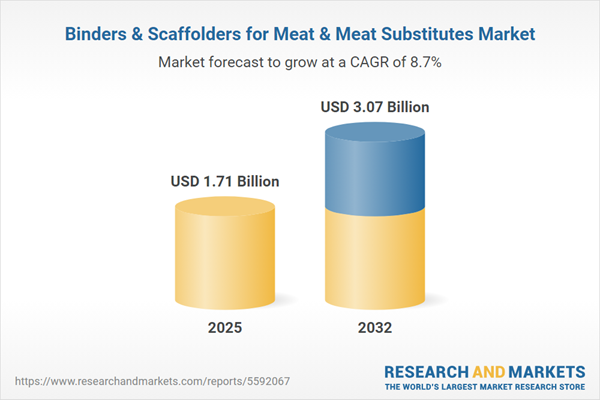Speak directly to the analyst to clarify any post sales queries you may have.
Strategic innovation is redefining the Binders & Scaffolders for Meat & Meat Substitutes Market, as global leaders adapt to emerging protein technologies and evolving regulatory demands. Decision-makers are refocusing investments, supply chains, and R&D efforts to sustain operational resilience and optimize their organizations’ competitive positioning.
Market Snapshot: Binders & Scaffolders for Meat & Meat Substitutes Market
The global Binders & Scaffolders for Meat & Meat Substitutes Market is experiencing robust compound annual growth, supported by an accelerated pace of ingredient innovation and process advancements. As market pressures drive transformation in both the conventional and alternative protein segments, industry participants are exploring next-generation polymeric and protein-based scaffolding agents. These technologies deliver authentic muscle textures, optimize product consistency, and ensure reliable performance. Clean-label transparency is influencing procurement and manufacturing, and operational models are shifting to support faster product launches and regulatory compliance across multiple regions.
Scope & Segmentation of the Market
This section details the key product categories, technology trends, and regional dynamics shaping strategic decisions for the Binders & Scaffolders for Meat & Meat Substitutes Market.
- Product Types: Alginate, carrageenan, methylcellulose, soy protein, starch, and wheat gluten deliver targeted texture, durability, and processing outcomes for high-performance protein products.
- Applications: Used in sausages, burgers, nuggets, meatballs, and ready-to-eat meals, binders and scaffolders maintain consistency and product appearance throughout distribution and storage.
- End Users: Food manufacturers, foodservice operators, and retail distributors rely on these ingredients to maximize reliability, extend shelf life, and sustain differentiation in fast-moving protein supply chains.
- Forms: Granules, liquids, pastes, and powders support diverse operational and manufacturing demands, facilitating flexible and scalable production strategies.
- Distribution Channels: Adoption is achieved through direct supplier contracts, international processing alliances, digital marketplaces, and collaboration across regional networks, supporting timely access to critical inputs.
- Regional Coverage: The Americas, Europe, Middle East & Africa, and Asia-Pacific each contribute to global growth, with regional teams adapting sourcing and compliance to match local regulations and consumer needs.
- Key Companies: Leaders such as Kerry Group plc, Koninklijke DSM N.V., DuPont de Nemours, Cargill, Ingredion, Tate & Lyle, Archer Daniels Midland, CP Kelco, Corbion, and Ashland advance innovation and steer industry progress.
Key Takeaways for Senior Decision-Makers
- Strategic selection of binders and scaffolders enables robust texture and streamlines manufacturing in expanding protein portfolios, helping organizations keep pace with dynamic consumer preferences.
- Growing interest in clean-label and natural ingredient solutions is driving changes across procurement and regulatory approaches, reinforcing transparency and compliance throughout the value chain.
- Collaboration among suppliers, technology developers, and research institutions accelerates the adoption of innovative scaffolding solutions across both traditional and alternative protein products.
- Performance studies underscore the relevance of freeze-thaw stability and allergen management, equipping firms to respond to evolving market demands and regulatory frameworks.
- Advanced process analytics and enhanced monitoring bolster ingredient consistency, drive operational reliability, and support ongoing quality control in protein ingredient manufacturing.
Tariff Impact: Strategic Responses to U.S. Policy Changes
Ongoing changes in U.S. trade policy require renewed focus on supply chain resilience. Industry participants are leveraging backward integration, expanding local sourcing networks, and optimizing procurement processes to reduce exposure to tariff volatility. These enhancements foster ingredient security and enable greater agility in responding to shifting market and regulatory environments.
Methodology & Data Sources
This assessment combines executive interviews, insights from innovation and supply chain experts, and in-depth analysis of regulatory documentation and proprietary industry reports. Every data point is validated for actionable relevance to current market stakeholders.
Why This Report Matters
- Enables leadership in research, procurement, and operations to benchmark internal strategies and proactively adapt to changing market and regulatory dynamics in the Binders & Scaffolders for Meat & Meat Substitutes Market.
- Presents targeted intelligence to inform technology investments and support agile alignment with evolving consumer and compliance trends.
- Equips senior decision-makers to lead innovation, foster collaboration, and optimize value realization in protein product development.
Conclusion
This report delivers the actionable intelligence required for informed, forward-looking decisions. Senior executives gain practical insights to sustain growth and agility in the evolving market for protein ingredient solutions.
Additional Product Information:
- Purchase of this report includes 1 year online access with quarterly updates.
- This report can be updated on request. Please contact our Customer Experience team using the Ask a Question widget on our website.
Table of Contents
3. Executive Summary
4. Market Overview
7. Cumulative Impact of Artificial Intelligence 2025
Companies Mentioned
The companies profiled in this Binders & Scaffolders for Meat & Meat Substitutes market report include:- Kerry Group plc
- Koninklijke DSM N.V.
- DuPont de Nemours, Inc.
- Cargill, Incorporated
- Ingredion Incorporated
- Tate & Lyle plc
- Archer Daniels Midland Company
- CP Kelco U.S., Inc.
- Corbion N.V.
- Ashland Global Holdings Inc.
Table Information
| Report Attribute | Details |
|---|---|
| No. of Pages | 195 |
| Published | October 2025 |
| Forecast Period | 2025 - 2032 |
| Estimated Market Value ( USD | $ 1.71 Billion |
| Forecasted Market Value ( USD | $ 3.07 Billion |
| Compound Annual Growth Rate | 8.6% |
| Regions Covered | Global |
| No. of Companies Mentioned | 10 |









